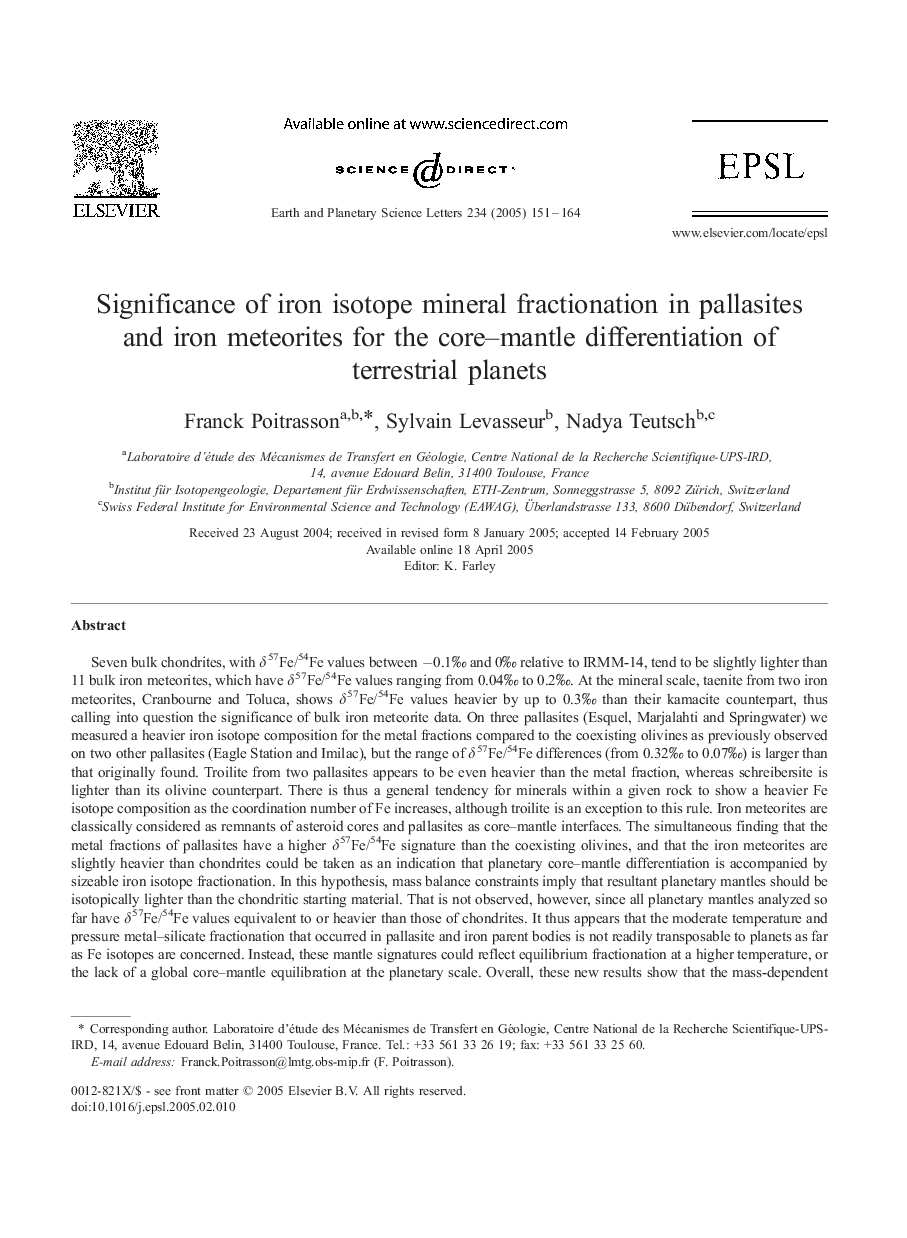| کد مقاله | کد نشریه | سال انتشار | مقاله انگلیسی | نسخه تمام متن |
|---|---|---|---|---|
| 9522269 | 1634966 | 2005 | 14 صفحه PDF | دانلود رایگان |
عنوان انگلیسی مقاله ISI
Significance of iron isotope mineral fractionation in pallasites and iron meteorites for the core-mantle differentiation of terrestrial planets
دانلود مقاله + سفارش ترجمه
دانلود مقاله ISI انگلیسی
رایگان برای ایرانیان
موضوعات مرتبط
مهندسی و علوم پایه
علوم زمین و سیارات
علوم زمین و سیاره ای (عمومی)
پیش نمایش صفحه اول مقاله

چکیده انگلیسی
Seven bulk chondrites, with δ57Fe/54Fe values between â0.1â° and 0â° relative to IRMM-14, tend to be slightly lighter than 11 bulk iron meteorites, which have δ57Fe/54Fe values ranging from 0.04â° to 0.2â°. At the mineral scale, taenite from two iron meteorites, Cranbourne and Toluca, shows δ57Fe/54Fe values heavier by up to 0.3â° than their kamacite counterpart, thus calling into question the significance of bulk iron meteorite data. On three pallasites (Esquel, Marjalahti and Springwater) we measured a heavier iron isotope composition for the metal fractions compared to the coexisting olivines as previously observed on two other pallasites (Eagle Station and Imilac), but the range of δ57Fe/54Fe differences (from 0.32â° to 0.07â°) is larger than that originally found. Troilite from two pallasites appears to be even heavier than the metal fraction, whereas schreibersite is lighter than its olivine counterpart. There is thus a general tendency for minerals within a given rock to show a heavier Fe isotope composition as the coordination number of Fe increases, although troilite is an exception to this rule. Iron meteorites are classically considered as remnants of asteroid cores and pallasites as core-mantle interfaces. The simultaneous finding that the metal fractions of pallasites have a higher δ57Fe/54Fe signature than the coexisting olivines, and that the iron meteorites are slightly heavier than chondrites could be taken as an indication that planetary core-mantle differentiation is accompanied by sizeable iron isotope fractionation. In this hypothesis, mass balance constraints imply that resultant planetary mantles should be isotopically lighter than the chondritic starting material. That is not observed, however, since all planetary mantles analyzed so far have δ57Fe/54Fe values equivalent to or heavier than those of chondrites. It thus appears that the moderate temperature and pressure metal-silicate fractionation that occurred in pallasite and iron parent bodies is not readily transposable to planets as far as Fe isotopes are concerned. Instead, these mantle signatures could reflect equilibrium fractionation at a higher temperature, or the lack of a global core-mantle equilibration at the planetary scale. Overall, these new results show that the mass-dependent isotopic scatter observed among inner solar system bodies from the bulk-rock to the planetary scale (â¼0.3Ⱐδ57Fe/54Fe) is more restricted than previously thought. This likely confirms a homogenization process that occurred in the protoplanetary accretion disk, between refractory inclusion condensation and chondrule formation.
ناشر
Database: Elsevier - ScienceDirect (ساینس دایرکت)
Journal: Earth and Planetary Science Letters - Volume 234, Issues 1â2, 30 May 2005, Pages 151-164
Journal: Earth and Planetary Science Letters - Volume 234, Issues 1â2, 30 May 2005, Pages 151-164
نویسندگان
Franck Poitrasson, Sylvain Levasseur, Nadya Teutsch,